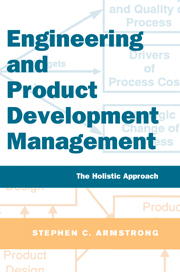Book contents
- Frontmatter
- Contents
- List of figures and tables
- Forewords
- Preface
- Acknowledgments
- Layout of book at a glance
- PART 1 UNDERSTANDING ENGINEERING PROCESS MANAGEMENT
- PART 2 APPLYING ENGINEERING PROCESSES TO PROGRAM MANAGEMENT
- PART 3 DEPLOYING ENGINEERING PROCESS MANAGEMENT
- PART 4 APPENDIXES
- A IPD maturity self-evaluation tools
- B Chapter 2 tables
- C Chapter 3 table
- D Pogram structuring and planning checklist
- E Chapter 8 tables
- F Understanding the ERP and the PDM connection
- Glossary
- References
- Index
A - IPD maturity self-evaluation tools
Published online by Cambridge University Press: 05 April 2014
- Frontmatter
- Contents
- List of figures and tables
- Forewords
- Preface
- Acknowledgments
- Layout of book at a glance
- PART 1 UNDERSTANDING ENGINEERING PROCESS MANAGEMENT
- PART 2 APPLYING ENGINEERING PROCESSES TO PROGRAM MANAGEMENT
- PART 3 DEPLOYING ENGINEERING PROCESS MANAGEMENT
- PART 4 APPENDIXES
- A IPD maturity self-evaluation tools
- B Chapter 2 tables
- C Chapter 3 table
- D Pogram structuring and planning checklist
- E Chapter 8 tables
- F Understanding the ERP and the PDM connection
- Glossary
- References
- Index
Summary
A.1 PURPOSE OF THE EVALUATION TOOL
This section contains an IPD Maturity Self-Evaluation Tool for assessing the status of integrated product development best practices on a program, as well as the overall maturity in IPD within a business. The results an be used to provide feedback to program managers, integration team members, integrated product team members, functional managers, and other site IPD stakeholders for process improvement activities. The survey can also help to identify new best practices in IPD by sharing lessons learned.
A.2 SCOPE OF THE EVALUATION TOOL
The evaluation tool/survey appears in Table A-1. It is structured in the form of statements of reality rather than questions of perception. It is also important to note that duplication between the sources has been eliminated, resulting in a single set of statements. Therefore, to receive an accurate assessment, a response to all the statements, regardless of their origin, is necessary. Additionally, at the end of the statements the assessor is given the opportunity to express subjective opinions, comments, and suggestions about the implementation and effectiveness of IPD in an essay-type format.
The user may choose to use this tool as a checklist to determine what IPD techniques are or need to be implemented; as a survey, responding to the statements in a “yes/no” fashion; or as a maturity indicator, where a specific response to each statement contributes to an overall measure of maturity.
- Type
- Chapter
- Information
- Engineering and Product Development ManagementThe Holistic Approach, pp. 251 - 257Publisher: Cambridge University PressPrint publication year: 2001



